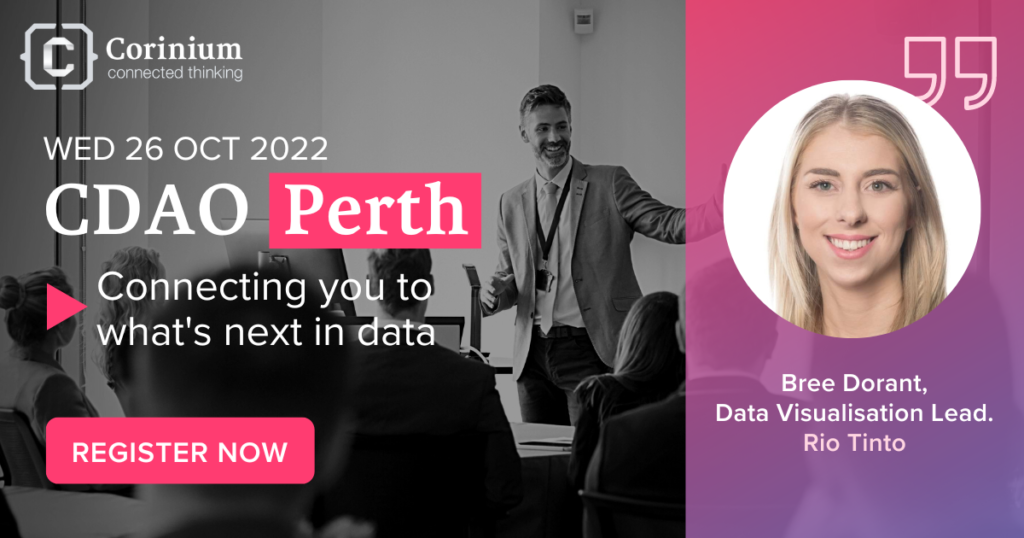Unlocking the Potential of Data Visualisation

Corinium Conference Director Alexandra Craggs recently caught up with Bree Dorant, Data Visualisation Lead at Rio Tinto, to explore how data and creativity combine to deliver data visualisations that are memorable.
Rio Tinto's Bree Dorant had an unusual route into the data space, having studied art before moving into economics. The Data Visualisation Lead believes the blend of skills between art and data is vital to deliver visualisations that engage and deliver insights.
“When someone has that blend of skills, it always seems to work out best. You want to be into coding, but if you also have that design flair, or an interest in art, the ability to bring these two together is really helpful” she says.
Dorant says having a combination of skills, both creative and analytical, is vital for success in a data visualisation role.
If not a flair for design, she believes that having an eye for detail and a bit of perfectionism – such as asking: ‘Does this line look good here?’ or ‘Can we position things this way?’ – is vital for people looking at a role in the space.
The Value of Engagement
When designing a visualisation, it is very easy to get lost in the process and develop something that, while completely logical to you, is confusing or lacks the information for someone else. To prevent this, Dorant argues that one of the key principles in anything you are developing is engagement.
"The only way you can really deliver a visualisation is by talking to people and doing lots of testing and iterative development because the users’ behaviour might take you down a completely different pattern to what you expected," she says.
Moreover, Dorant points to the nuances of data and how important they are when building visualisations and asking questions of them. For example, even simple questions like, ‘How much did I spend in a year?’ can have multiple meanings. Is that a financial year? A lunar year? A calendar year? By spend are you referring to any money that has left an account? Or spending on specific products/vendors? Asking questions is vital to ensuring a visualisation is delivering what the user needs.
Dorant also points out how engagement helps lower adoption barriers, particularly when you are introducing new systems. From her experience, if you share some insights, users will want to know, or at least understand, how that was achieved through the data. This can bring complexity back into the process. Instead, engagement helps boost user confidence in the results they are presented with in dashboards.

Understanding the Interplay: Psychology and Visualisations
When we talk about psychology, data visualisations are not usually something that springs to mind, but Dorant points to its importance when building visualisations that are memorable, using both our short and long-term memory.
When using our short-term memory, our brains are good at identifying visual patterns – such as the largest bar in a bar chart – but less good at interpreting lines upon lines in a spreadsheet. This means that visualisations need to be designed with readability in mind, in a way that showcases information the brain can digest easily.
When it comes to long-term memory, Dorant discussed “looking around the Internet, rather than creating your own beautiful system”.
This, she points out, is because most websites look the same, and when you try to use them, your brain already has some context of how it should work. Rather than the confusion of learning a new system (if you have ever tried switching between a Mac and Windows you will know how confusing this can be!) your brain will intuitively be able to use the visualisation and therefore ingest it quicker.
Dealing with Complexity
According to Dorant, complexity is a problem. Both in terms of the technical data modelling side and the dashboard presenting side.
As companies create increasing amounts of data, they need to ensure they have the tools and resources to manage these. Thankfully, there are a number of great tools available now that can handle data quantities. However, when it comes to visualisations, Dorant’s advice is not to put too much data into a presentation, as this can muddy the message, create more confusion and actually take away value from what you have created.
Limitations, she argues, must be accepted and the data visualisation process should be undertaken step by step. This allows you to build up the complexity only when the previous step is achieved and workable. Moreover, she points out, by engaging the users throughout the development process, they are more accepting of any limitations in the visualisation.
Don't miss the opportunity to hear more from Bree and other data and analytics leaders at our CDAO Perth event in October 2022. Click here to join us!


/BoD_Digital_Atlas.jpg?width=352&name=BoD_Digital_Atlas.jpg)
